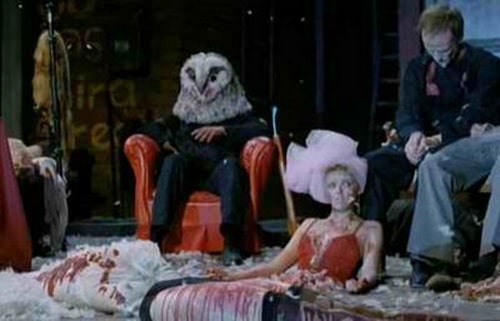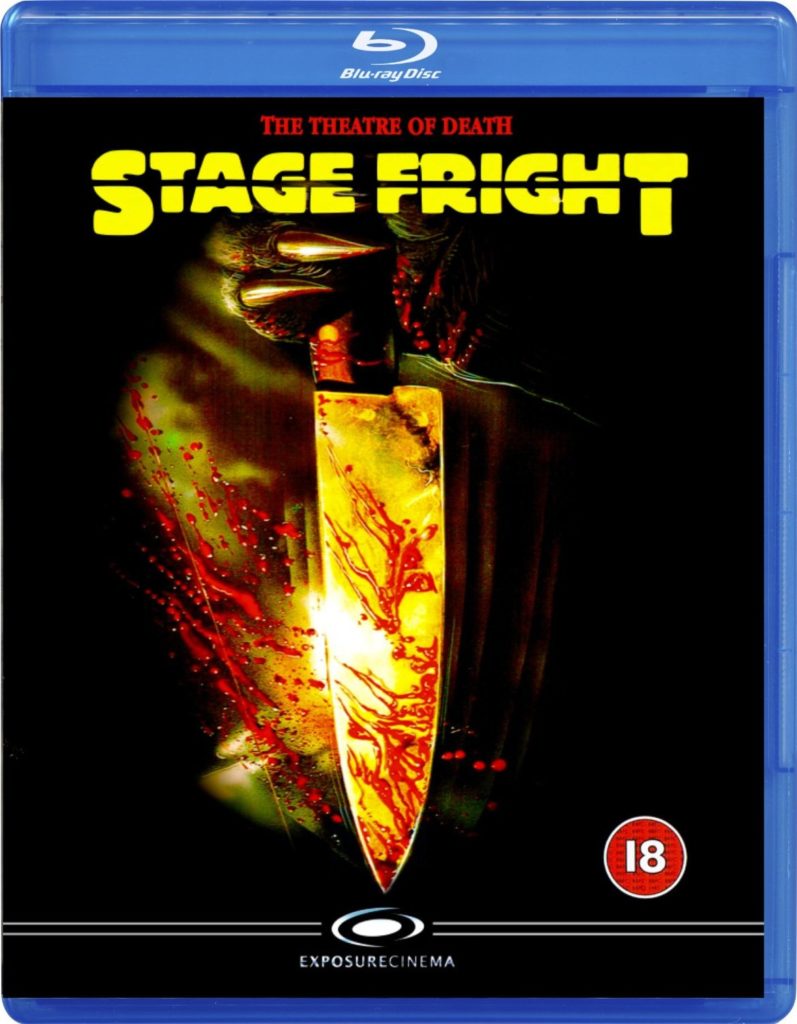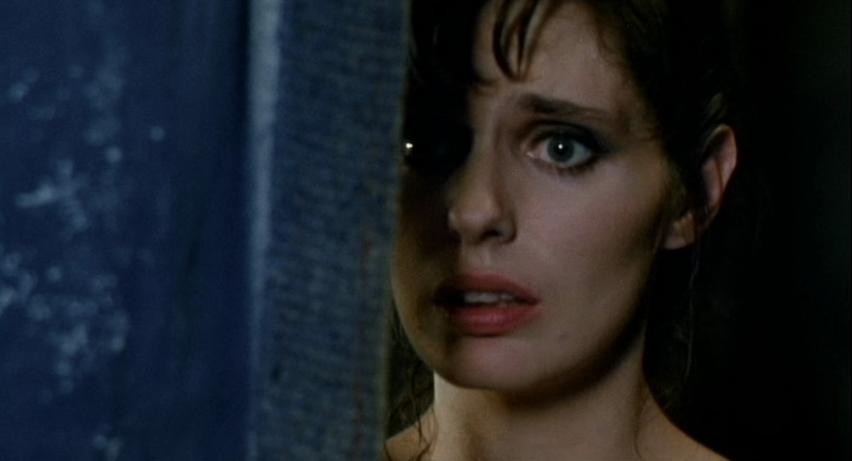Note: this feature contains spoilers!
 In a small US theatre, the cast of avant-garde performance The Night Owl are readying themselves for their big opening night. In true Stanislavsky style, the director wants everyone locked in, so that they can really get into their roles. This is a health and safety disaster waiting to happen in its own right, so it’s even more of a shocker when a psychopathic luvvie breaks out of a nearby psychiatric hospital that very night, dons the suitably eerie owl mask being used in the performance and then runs amok, picking off the actors one by one. Yep, this is the film most commonly now known as Stage Fright (or StageFright, but I’ll stick with the distinct words if I may), the first film made by director Michele Soavi as a foray away from his mentor Dario Argento: it carries a lot of the hallmarks of Argento’s work, as you’d suppose it might, but it also shows a director already more than capable of committing his own style to celluloid.
In a small US theatre, the cast of avant-garde performance The Night Owl are readying themselves for their big opening night. In true Stanislavsky style, the director wants everyone locked in, so that they can really get into their roles. This is a health and safety disaster waiting to happen in its own right, so it’s even more of a shocker when a psychopathic luvvie breaks out of a nearby psychiatric hospital that very night, dons the suitably eerie owl mask being used in the performance and then runs amok, picking off the actors one by one. Yep, this is the film most commonly now known as Stage Fright (or StageFright, but I’ll stick with the distinct words if I may), the first film made by director Michele Soavi as a foray away from his mentor Dario Argento: it carries a lot of the hallmarks of Argento’s work, as you’d suppose it might, but it also shows a director already more than capable of committing his own style to celluloid.
There’s so much to love about this film, and perhaps after an interval of thirty years one of the first things you notice is just how roaringly 80s it is: not the most compelling opening statement to make about a film from this era, true, but for someone who grew up in the 80s, a patterned stocking here, some teased hair there and the addition of a Cramps shirt are all pleasantly familiar, because nostalgia can have a pull as strong as gravity: on a superficial level, Stage Fright starts life as Flash Dance with added weapons, a horror riff on a new on-screen trend. But, at a safe distance, you can see less salubrious elements too – people struggling to make their rent, a woman so hellbent on retrieving her damn gold wristwatch that she will risk death to get it back (several times) and the sleazy, predatory money man who has a say both in how the play is performed and what the girls do for him. Quelle change, I suppose, but for me it has that veneer of its era. Not for nothing does Soavi give us the scene where blood spatters over a stack of dollar bills – it’s like a little symbolic ode to the decade.
 For all that, this is a horror film, and by this point in the 80s, horror was established enough and popular enough to be self-referential on a scale not seen before: horror cinema had often become about the knowing nod, relying on audiences to know some of the conventions, or at least to have seen enough of the wealth of films already floating around and far more readily available, thanks to good ol’ analogue technology. Freddy Krueger was doing the rounds by now, wisecracking and gurning for the camera as he terrorized teenagers; Henenlotter was grossing audiences out with his body gore gags; even Romero could afford to reference his own work in the otherwise relentlessly grim Day of the Dead (remember the little jingle from Dawn which plays over the zombie being left in the dark to ‘think about what he’d done’?) Stage Fright, too, is often cleverly self-referential, and deserves more dues for it. The whole film-about-a-play which is itself based on an exploitation script, where in one scene director Peter matter-of-factly announces that it’s time to give the rape scene a go, seems to me to be a spin on the behind-the-scenes elements of many of the films being made under the masked killer banner around this time. It’s an actor who initiates the horror here, after losing his mind in his acting career.
For all that, this is a horror film, and by this point in the 80s, horror was established enough and popular enough to be self-referential on a scale not seen before: horror cinema had often become about the knowing nod, relying on audiences to know some of the conventions, or at least to have seen enough of the wealth of films already floating around and far more readily available, thanks to good ol’ analogue technology. Freddy Krueger was doing the rounds by now, wisecracking and gurning for the camera as he terrorized teenagers; Henenlotter was grossing audiences out with his body gore gags; even Romero could afford to reference his own work in the otherwise relentlessly grim Day of the Dead (remember the little jingle from Dawn which plays over the zombie being left in the dark to ‘think about what he’d done’?) Stage Fright, too, is often cleverly self-referential, and deserves more dues for it. The whole film-about-a-play which is itself based on an exploitation script, where in one scene director Peter matter-of-factly announces that it’s time to give the rape scene a go, seems to me to be a spin on the behind-the-scenes elements of many of the films being made under the masked killer banner around this time. It’s an actor who initiates the horror here, after losing his mind in his acting career.
Tellingly, Peter is also insistent that when serial killer Irving Wallace gets loose, a ‘real event’ like this will help him to sell theatre tickets. Again, how many horror films have been either based on real events, or even rumoured to contain ‘real footage’? Peter’s an old crook, but he might even be right – well, so long as there are enough actors left to perform. Also, back when Stage Fright was made, it took its place amongst a number of films where antagonists deliberately broke the specific ‘fourth wall’ of the TV/cinema screen (like The Video Dead, Demons 2) or the horror begins in a theatre or cinema, such as Demons (which has a lot of crossover cast members with Stage Fright). Threat and murder merge with performance: bodies become props, and in Stage Fright the final, most obvious nod to genre film is in the glaringly obvious and literal murder set piece which Wallace eventually puts together. I suppose today we might call all of this ‘meta-‘, but in our jaded twenty-first century parlance, that’s become a bit pejorative, sadly. We’ll just say instead that Stage Fright does more than tell a straightforward story, whilst managing not to forget to tell it altogether.
In many ways, Stage Fright belongs squarely in the by-now-established slasher genre, a place where it’s often filed away: early promotional materials emphasised the goriness, and in fairness, we have the nasty weapons, the omniscient killer and the ubiquitous ‘final girl’. But, this is a Soavi film. Not content to tell a story within a story and just hack and stab a route straight through it, Stage Fright also manages to interweave some of the Gothic elements which had been appearing in the genre since Bava first blazed a trail – linking gialli to Gothic – and which led to Argento bringing his creepy aesthetics to violent gore. Soavi’s adaptation of Gothic elements is gentler and more traditional than Argento, I feel (it’s also quite coy on nudity, as an aside) but the Gothic is undoubtedly there. The pathetic fallacy of an ominous rainstorm had been doing the rounds for centuries, then we have a black cat stalking through the set (completely unperturbed by the human suffering, obviously) and what looks like a Gothic artist Caspar David Friedrichs-style painted backdrop, at one side of the 80s backdrop being used by the Night Owl cast. Oh, and a huge mad owl, which is pretty Gothic too. After cutting his teeth on a Gothic slasher, Soavi went on to make a Gothic zombie movie in Dellamorte Dellamore – so he clearly enjoys using these aesthetics into his work, and does so brilliantly.
All of this, and in a well-paced, taut piece of cinema which doesn’t waste aimless minutes trying to be ponderous or edgy. It’s a roll call of genre stars, too, with Giovanni Lombardo Radice doing a camp turn as a dancer, Barbara Cupisti as Alicia, David Brandon as the sardonic Englishman Peter (catch the future echoes of Francesco Dellamorte) and – though he’s uncredited – it’s the co-writer of the film and Anthropophagus the Beast himself, George Eastman, running around with the owl head on. Keen eyes might also notice the Anthropophagus promo photograph perched in one of the dressing rooms. Just to throw one more name in here, a trivia fact on IMDb suggests that sleaze lord director Joe D’Amato at one time planned to remake Stage Fright under the title Willy Shocks Treatment, where the killer would be clad in light bulbs, but I’m not sure if my mind can fully comprehend this…anyway…
Soavi continued to explore the Gothic in The Church, refining his own visual style and atmosphere, but sadly concluded his forays into the horror genre with Dellamorte Dellamore (Cemetery Man) – which is one of my favourite films – in the early Nineties. As my co-writer Ben said when I mentioned writing this piece, Soavi has been residing in the ‘where are they now?’ category ever since, at least as far as film fans would appreciate it: these days, his filmography is awash with TV movies, which don’t look particularly engaging to my (admittedly untrained) eye. So why did such a promising and innovative director pack it all in, when he seemed to be on the up?
This is always a difficult one for me, as I suppose I want directors whose work I like to be as dedicated to genre film as my imagination supposes they are. In actuality, there are lots of other factors at play, one of which might well be a complete distaste for making any more horror, as well as the usual stuff about money and funding. And then, Soavi’s old mentor Argento is still making horror films, and his work has progressed from the sublime to the ridiculous, so…a long career in horror can be a difficult path to take. You never know what the future will hold. But at least I’ve seen a film about a mad killer in an owl mask at least once, and I think we can appreciate, even at thirty years on, what a well-executed piece of horror entertainment Stage Fright really is. Should Michele Soavi ever fancy a return to this kind of fare, it’d be impossible not to welcome it.
